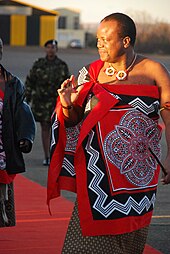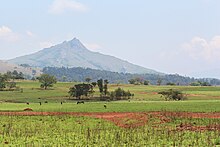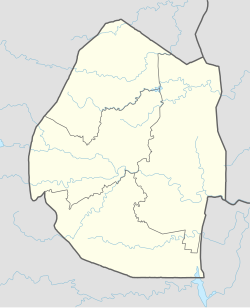Lobamba
Lobamba | |
|---|---|
 Eswatini parliament building in Lobamba | |
| Coordinates:26°25′0″S31°10′0″E/ 26.41667°S 31.16667°E | |
| Country | |
| District | Hhohho |
| Elevation | 694 m (2,277 ft) |
| Population (2006) | |
| • Total | 9,900 |
| Time zone | UTC+2(SAST[2]) |
| Area code | 416 (country code +268)[3] |
| ISO 3166 code | SZ/SWZ[4] |
Lobambais acityinEswatini,and is one of the twocapitals(along withMbabane), serving as thelegislative,traditional,spiritual,seat of governmentof theParliament of Eswatini,[6]andLudzidzini Royal Village,the residence ofQueen Ntfombi,theQueen Mother.[7][8]
Mswati IIIlives about ten kilometres (6 mi) away at the Lozitha Palace. The King and Queen Mother participate in annual December and JanuaryIncwalaceremonies and August and SeptemberReed Dancesat Ludzidzini Royal Village, also known as the RoyalKraal.
Key attractions are the Parliament, National Museum of Eswatini,Mlilwane Wildlife Sanctuary,and the King Sobhuza II Memorial Park. The Embo State Palace, not open to visitors, was built by the British government for thepolygamousKingSobhuza II,whose family included 600 children. He led the movement for Eswatini's independence from the United Kingdom and was its first prime minister.
Overview
[edit]It is located in the western part of the country[9]in the woodland "Valley of Heaven", orEzulwini Valley.[10]It is 16 kilometres (10 mi) fromMbabane,in the district ofHhohho[7]and has asubtropical climatewith wet summers and dry winters.[9]

In 1997 its population was 3,625.[7]Its population in 2006 was 11,000.[11]Across the country, 84.3% of its people areSwaziand 9.9% areZulu.The remainder areTsonga(2.5%),Indian(1.6%) and others (1.7%). Its official languages areSwaziandEnglish.[9]
History
[edit]Two areas have been called Lobamba, the first now called "Old Lobamba" was established in 1750 in southern Eswatini. The subject of this article is a settlement that was created bySobhuza IIin the northwest section of the country.[12][nb 1]
In 1903, following theBoer Wars,the British government took control of Eswatini and it was then ruled by aregent.In 1921 KingSobhuza IIbecame leader of Eswatini, which was still under the British government's control.[16]Eswatini became independent of the British government on September 6, 1968, which was announced at a cattlebyrein Lobamba byPrince Makhosini.He was the country's first prime minister and the great-grandson ofSobhuza I.With its independence, Eswatini was a member in its own right of theOrganization of African Unity(OAU),British Commonwealth,and theUnited Nations.[17]It was made aconstitutional monarchyunder Sobhuza II,[18]who lived in the royal residence, orkraal,in Lobamba.[18]
Government
[edit]
April 1986–present
Lobamba is the legislative seat of theEswatinigovernment.[6]
Parliament of Eswatini
[edit]It was made a branch of theCommonwealth Parliamentary Associationon January 1, 1965, and its date of independence was January 1, 1968. The constitution was signed by KingMswati IIIon July 26, 2005. Thekingappoints theprime ministerand the council. There are two chambers: the Senate and the House of Assembly.[6]The parliament building is sometimes open to visitors.[19]
Embo State Palace
[edit]The royal Embo State Palace was built by the British to house thepolygamousSobhuza IIand his family, including 600 children. It is not open to visitors and photographs are not allowed.[10][19]
Royal residences
[edit]KingMswati IIIlives at the Lozitha Palace, about ten kilometres (6 mi) from the city. He visits the Royal Kraal, or Ludzidzini Royal Residence, during theUmhlanga danceandIncwalaceremonies.[19]The royal village includes the queen mother's Royal Kraal, dwelling clusters, and a parade ground for ceremonies.[20]
Infrastructure
[edit]Law enforcement
[edit]
Lobamba has a police station and is served by The Royal Eswatini Police Service.[21]During the British colonial eraLord Selborne,High Commissioner for South Africasigned a proclamation in 1907 for what became the Eswatini Police Force. After Eswatini's independence in 1968, the force was renamed the Royal Eswatini Police Force. Its name was further changed making it a service, rather than a force.[22]
Education
[edit]Education is free, but is not required. It had low literacy rates, but they are rising.[9]Lobamba National High School is in Lobamba.[23]
Health and welfare
[edit]The government provides health facilities to manageendemic diseaseandmalnutrition.Retirement, disability and survivor pensions are available through its welfare system.[9]
Transportation
[edit]Many of the roads in Eswatini are unsurfaced, but there are good roads that connect principal towns,[9]including theMR3highway and MR103 road.[10]There are small local airstrips and a railroad that operates between Eswatini and Mozambique.[9]TheMatsapha Airportis 23 kilometres (14 mi) from Lobamba. The next closest domestic and international airport isMaputo International Airportin Mozambique, which is 216 kilometres (134 mi) away.[24]
One of the tour operators in Eswatini is Swazi Trails, which has tours of the Lobamba royal village, nature reserves, game parks, and craft centres. Nabo Bashoa runs minibus tours.[25]
Culture and attractions
[edit]African Life. Some of the Sons of the Late Chief Bokweni Mamba.
National Dancing at Lobamba (1951)
National Museum of Eswatini
[edit]The National Museum of Eswatini, located in Lobamba next to theParliament building,was built in 1972 and expanded in 1986 and 1990.[14][26]The museum was made a non-profit institution in 1974 by theInternational Council of Museums.[26]
The museum houses a memorial to the revered KingSobhuza II[19]andSwaziandSouth Africanartifacts. It has a collection of photographs that include subjects of theMbabaneandManzini RegionsandBritish colonialadministrators. A 16th-century head ofKrishna,discovered nearby, is located in thenatural historywing and provides evidence of trade with theeast.[14][26]The natural history wing includeshighveldandlowvelddioramasto illustrate the diverse Eswatini ecosystems and feature rarely seen nocturnal animals. Its nature-centric exhibits integrate environmental and cultural impacts.[20]
A recreation of aSwazi homesteadis located outside the museum.[14]
Somhlolo stadium
[edit]Also located near the Parliament building is theSomhlolo stadiumfor football and other major events.[14]

Mlilwane Wildlife Sanctuary
[edit]Just outside Lobamba is the Mlilwane Wildlife Sanctuary that has horseback and hiking trails, guided mountain-bike tours, rustic trail camps and camping in caves. Throughout the park are opportunities to observe game,[14]includingantelope,giraffe,zebras,and many types of birds.[27]
King Sobhuza II Memorial Park
[edit]A memorial park was established in the memory of KingSobhuza II,who was the leader of the country's independence in 1968. The king's life is told through an exhibit of photographs. Three of the king's vintage cars are in the museum and his mausoleum is within the park.[20]
Malkern Valley
[edit]Malkerns Valley is an arts and crafts center locatedseven kilometres (4+1⁄2mi) south of Lobamba.[28]
Events
[edit]Ceremonies
[edit]Lobamba is famous for two ceremonies that are held there: theReed Dance,[7]celebrated in August and September in honour of the Queen Mother, and theIncwala,[7][29]in December and January in honour of the King. These ceremonies include dancing, singing, and celebrations with traditional attire.[30][31]
See also
[edit]- Swaziland National Trust Commission- operates the National Museum of Eswatini
Notes
[edit]- ^In the mid 18th century ancestors ofSobhuza Icame to (old) Lobamba from the north.[13]About 1750 Swazi was founded in (old) Lobamba byDlamini dynastychiefNgwane III,according to local tradition. His son,Ndvungunye,died in 1815 andSobhuza Ibecame the king and founder of modern Eswatini, ruling from hisShiselweniroyal residence beginning in 1818. The city of (old) Lobamba was built in 1820 as headquarters for Sobhuza I, who died in 1838.[14][15]
References
[edit]- ^Elevation of Lobamba,Swaziland Elevation Map, Topo, Contour.Floodmap.net. Retrieved April 20, 2014.
- ^Lobamba.Time Zone Genius. Retrieved April 20, 2014.
- ^Lobamba.Archived2014-04-23 at theWayback MachinePhone Area Code Dialing. Retrieved April 20, 2014.
- ^Lobamba.PostCodesDB. Retrieved April 20, 2014.
- ^Lobamba.GeoPostCodes. Retrieved April 20, 2014.
- ^abc"The Parliament of Swaziland"Archived2016-03-04 at theWayback Machine.Commonwealth Parliamentary Association. Accessed April 7, 2014.
- ^abcde"Lobamba".Encyclopædia Britannica. Accessed April 8, 2014.
- ^Ruth Cyr.Twentieth Century Africa.iUniverse; 2001.ISBN978-0-595-18982-3.p. 485.
- ^abcdefgPeter Haggett.Encyclopedia of World Geography.Marshall Cavendish; 1 July 2001.ISBN978-0-7614-7289-6.p. 2477.
- ^abcKate Armstrong.South Africa, Lesotho & Swaziland.Lonely Planet; 2006.ISBN978-1-74059-970-2.p. 582.
- ^Encyclopædia Britannica, Inc..Britannica Book of the Year 2010.Encyclopædia Britannica, Inc.; 1 March 2010.ISBN978-1-61535-366-8.p. 706.
- ^Laurel L. Rose.The Politics of Harmony: Land Dispute Strategies in Swaziland.Cambridge University Press; 31 January 1992.ISBN978-0-521-39296-9.p. 65.
- ^Bridget Hilton-Barber.Weekends with Legends.New Africa Books; 2001.ISBN978-0-86486-471-0.p. 158.
- ^abcdefPinchuck, Tony (July 5, 2012).The Rough Guide to South Africa, Lesotho & Swaziland.Penguin.ISBN9781405390453.
- ^Emmanuel Kwaku Akyeampong; Henry Louis Gates.Dictionary of African Biography.Oxford University Press; 2 February 2012.ISBN978-0-19-538207-5.p. 424.
- ^Ruth Cyr.Twentieth Century Africa.iUniverse; 2001.ISBN978-0-595-18982-3.p. 485, 488.
- ^Emmanuel Kwaku Akyeampong; Henry Louis Gates.Dictionary of African Biography.Oxford University Press; 2 February 2012.ISBN978-0-19-538207-5.p. 233–234.
- ^abRuth Cyr.Twentieth Century Africa.iUniverse; 2001.ISBN978-0-595-18982-3.p. 488.
- ^abcdAlan Murphy; Kate Armstrong; James Bainbridge.Lonely Planet Southern Africa.Lonely Planet; 2010.ISBN978-1-74059-545-2.p. 592.
- ^abcLobamba: Attractions.The Kingdom of Swaziland. Retrieved April 20, 2014.
- ^Lobamba Police Station.The Royal Swaziland Police Service. Retrieved April 7, 2014.
- ^Brief History.The Royal Swaziland Police Service. Retrieved April 20, 2014.
- ^Ndzimandze, Mbongiseni (September 12, 2009)."Lobamba National High snatches investment challenge".Weekend Observer.Accessed April 7, 2014.
- ^Lobamba, Swaziland.Travel Math. Retrieved April 21, 2014.
- ^South Africa.Rough Guides; 2002.ISBN978-1-85828-853-6.Ncwala and Umhlanga ceremonies. p. 801.
- ^abc"National Museum".Swaziland National Trust Commission. Accessed April 7, 2014.
- ^Alan Murphy; Kate Armstrong; James Bainbridge.Lonely Planet Southern Africa.Lonely Planet; 2010.ISBN978-1-74059-545-2.p. 584.
- ^James Bainbridge.South Africa Lesotho and Swaziland.Lonely Planet; 15 September 2010.ISBN978-1-74220-375-1.p. 588.
- ^James Bainbridge.South Africa Lesotho and Swaziland.Lonely Planet; 15 September 2010.ISBN978-1-74220-375-1.p. 613.
- ^"Ncwala and Umhlanga ceremonies." InSouth Africa.Rough Guides; 2002.ISBN978-1-85828-853-6.p. 805.
- ^IncwalaThe Kingdom of Swaziland. Retrieved April 20, 2014.
Further reading
[edit]- Dlamini, Welcome (June 27, 2013)."Majahodvwa takes potshot at colleague".Times of Eswatini.Accessed April 7, 2014.
- O'Cuneen, Pamela (June 1, 2013)."Party time in Lobamba".The Australian.Accessed April 7, 2014.
External links
[edit]- "Geography of Eswatini",swazidirectory.co.sz
- Lobamba Travel Guide.Virtual Tourist.

